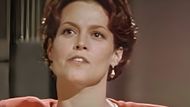Copycat is a psychological thriller film released on October 27, 1995, by Warner Bros. It is directed by Jon Amiel, with David Madsen and Ann Biderman as the writers. The film is produced by Mark Tarlov and Arnon Milchan under Regency Enterprises. Here is the official synopsis as per Letterboxd.
An agoraphobic psychologist and a female detective must work together to take down a serial killer who copies serial killers from the past.
It stars Sigourney Weaver and Holly Hunter, among others, in pivotal roles. Let’s look at how the film ends and the identity of the killer.
How does Copycat end?

Copycat centers on Dr. Helen Hudson (Weaver), a criminal psychologist. She teams up with homicide detective Mary Jane Monahan, also known as M.J. (Holly Hunter), to track down a serial killer who is committing a series of copycat crimes.
Toward the end of the film, Peter Foley (William McNamara) is about to kill M.J., but Helen chooses to hang herself. She does this to stop him from continuing his series of crimes. Seeing this, Foley cuts the rope Helen is holding, causing her to fall. However, she cannot leave the area and turns back to Foley. The killer points his gun at her and is about to shoot. At that moment, M.J. arrives and shoots at him. While M.J. wants him to surrender, Foley raises his gun toward her, prompting her to shoot and kill him.
Later, we see Daryll Lee Cullum (Harry Connick Jr.) inside the prison writing a letter to a serial killer. He is instructing the killer on how to eliminate Helen. It is revealed that he was helping Foley throughout the film.
Who was the killer in Copycat?
We identify the serial killer in Copycat as the story reaches its midpoint. As previously mentioned, Peter Foley is confirmed to be the main suspect behind the deaths. Helen estimates that the suspect is a male between 20 and 35 years old.
Foley is someone who can blend into a crowd and look like any other man. He lives in a modest home with his wife but leads a double life. His house has a basement he calls a funhouse. Foley is on a killing spree, committing crimes to gain notoriety, and he wants to redo the previous murders. This drives him to imitate earlier serial killers.
The ending of the film remains open-ended. Our protagonist manages to stop one murderer, but the cycle is likely to continue. Daryll's final moment suggests that another copycat killer could be emerging, ready to start harming people. This leaves room for a story that can keep going.
The film grossed $79 million and received positive reviews upon its release. It also performed well in the rental market after its theatrical run.
What are your thoughts on the film's ending?
Stay tuned to Soap Central for more such stories.
Love movies? Try our Box Office Game and Movie Grid Game to test your film knowledge and have some fun!
